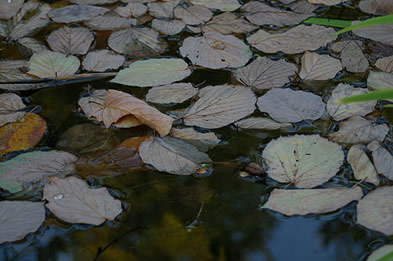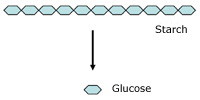
Preview
Material for Exam 1 - Fall 2006
Print
the PDF version (no pictures, better printing)

Scientists working in a remote part of South America came upon a series of small ponds, some of which contained numerous dead fish floating on the surface. They also noticed that some of the ponds had leaves from nearby trees floating in the water. There appeared to be two different kinds of trees and the scientists concluded that wind associated with a recent rainstorm had stripped the leaves from the trees and blown them into the ponds. To determine if the observed fish deaths were associated with the presence of leaves from nearby trees the scientists collected the following data:
Pond 1 |
Pond 2 |
Pond 3 |
Pond 4 |
|
Number
of leaves |
15 |
22 |
5 |
0 |
Number
of leaves |
25 |
4 |
1 |
0 |
Number of dead fish |
8 |
14 |
2 |
1 |
To investigate the problem in more detail the scientists set up artificial ponds made from cattle tanks. They collected fish and water from ponds that contained no leaves of either species of tree and added equal amounts of water and fish (25 fish per pond) to each artificial pond. They placed leaves in the water as outlined below and after 2 days collected the following results from the 20 ponds:

Pond
#s |
Pond
#s |
Pond
#s |
Pond
#s |
Pond
#s |
|
Leaves from Species 1 |
0 |
15 |
30 |
0 |
0 |
Leaves from Species 2 |
0 |
0 |
0 |
15 |
30 |
Avg. # of dead fish/pond |
0 |
10 |
22 |
0 |
0 |

You are a scientist studying the rare three-eyed lizard. You have been sampling the lizards in Payne County, OK to assess their population size. You have been surprised by how warm the lizards feel when you handle them. This interests you because the lizards are ectothermic and yet they are always several degrees warmer than the air.
You design an experiment to test if radiation from the sun is warming the lizards. You put 10 lizards in clear plastic cages that allow the lizards to be exposed to sunlight (full radiation), 10 lizards in cages made from cardboard that block all sunlight (no radiation), and 10 lizards in grey translucent plastic containers that let only a little sunlight in (1/2 full radiation). You attach a thermometer (no lizards were harmed in this experiment) to each lizard to measure its temperature. You also measure the air temperature and humidity in each cage so you will know if any differences among replicates or treatments occurred

Dr. Microo isolated a new species of bacterium from the tropical rainforest of Central America. He wanted to determine the effect of temperature on the population growth rate of this new species. He designed and conducted the experiment and gathered data. When he prepared to write up the data up for publication, he decided to graph the effects of temperature on the growth rate of this bacterium. Bacteria are single celled organisms that are poikilotherms.
In another experiment, Dr. Microo grew his new bacterium in the presence of a compound that was known to make the cell membrane leaky to protons (H+). He then made several measurements. A bacterial cell functions like an individual mitochondrion in a eukaryotic cell.
Pat measures the metabolic rate of two animals at three temperatures using O2 consumption and obtains the following data:
Temperature |
Organism A |
Organism B |
5ºC |
3 µl/hr |
3400 µl/hr |
22ºC |
8 µl/hr |
1600 µl/hr |
35C |
19 µl/hr |
2400 µl/hr |
Seeds consist of embryos (which will develop into seedlings and eventually mature plants) and tissue that stores food, usually starch, surrounded by seed coats. When a seed matures on a plant, it is shed and falls to the ground where it will remain dormant (a state characterized by a very low rate of cellular aerobic respiration) for one or more years before germinating. Germination is initiated when the seed absorbs water from the soil. The starch stored in the seed provides the initial energy for seedling development, but for this to happen, amylase, one of the many enzymes activated during germination, must break down starch into glucose.

 source
source
Monarch butterfly caterpillars often consume milkweed, a plant that produces a secondary metabolite. The caterpillars do not appear to be hurt by the secondary metabolite in any way but if birds eat the butterflies, the birds become violently ill.

A medical researcher was interested in testing the effectiveness of vitamin E on the rate of healing of burns. She gathered 90 people who had mild burns and divided the group into thirds. One third of the group was treated with 5,000 µg of vitamin E per day, one third was treated with a brand-name burn-medication and the last group was treated with cold compresses. The vitamin E group recovered faster, but the burn-medication group was more comfortable, while burns in the cold-compress group took longer to heal.